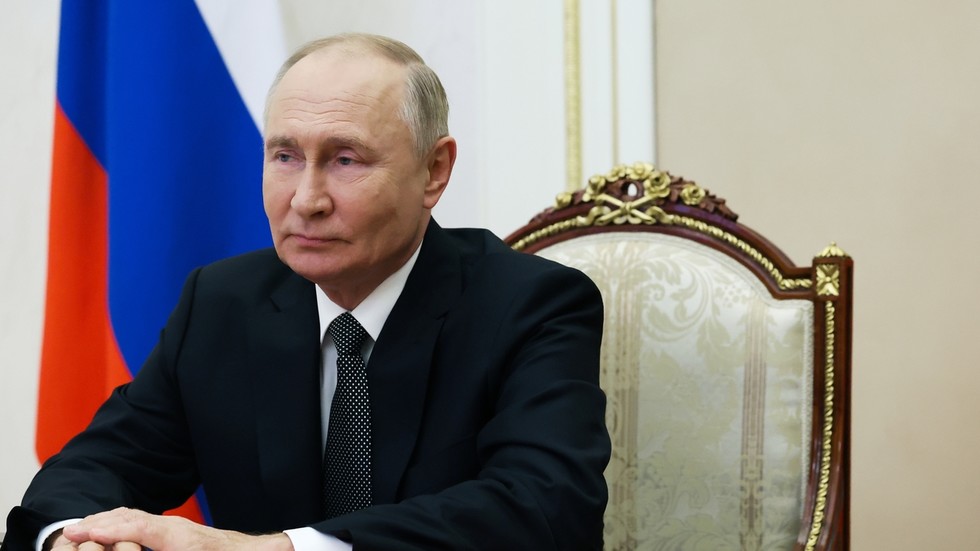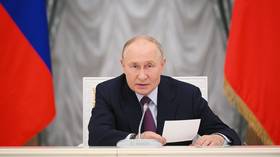
The president has cleared up any ambiguity about how Moscow will respond to any new threats in its backyard

By Sergey Poletaev, information analyst and publicist, co-founder and editor of the Vatfor project.
By Sergey Poletaev, information analyst and publicist, co-founder and editor of the Vatfor project.
Vatfor project

Russian President Vladimir Putin chairs a meeting with members of the Security Council via videoconference at the Kremlin in Moscow, Russia. © Sputnik / Sputnik
On September 26, Russian President Vladimir Putin announced updates to the Foundations of State Policy of the Russian Federation in the Area of Nuclear Deterrence. The revised document implies that under certain conditions, Moscow may consider a proxy war against itself as justification for using nuclear weapons.
Salami tactics
Traditional nuclear deterrence doctrines date back to the Cold War and were developed with major world powers and military alliances in mind. The underlying assumption is that large states are unlikely to attack a nuclear power, since they risk facing a massive retaliatory strike.
However, the conflict in Ukraine has created a new and unprecedented reality: The West is waging war against Russia through a proxy state that shows little regard for its own self-preservation. At least under the grip of its current leadership.
Kiev actively attacks Russia’s historic territories. Incidents that have happened “for the first time since World War Two” are regularly reported in the news: e.g., a regional center being shelled in Russia, military facilities attacked in Volga Region or in the Kuban, or German-made tanks crossing into Kursk Region.
There have also been rumors of attacks on sites of Russia’s strategic nuclear forces. Such aggression is officially recognized as triggers for a nuclear response. Whether or not these rumors are true, this behavior is perfectly in line with the logic of Kiev and its Western sponsors. The goal is to use isolated drone strikes conducted by a proxy force to undermine Russia’s nuclear doctrine – or, speaking in IT terms, to hack it by means of a ‘zero-day exploit’.


Read more
After all, would Putin really start a nuclear war over one drone crashing near a strategic bomber base? What about two drones? Or ten? Or perhaps a couple of drones combined with a Western-made cruise missile?
This exemplifies classic ‘salami slicing tactics’: gradually pressuring the opponent, forcing them to change their strategic position without providing sufficient grounds for the opponent to deploy their primary (in Russia’s case – nuclear) forces.
Staying behind the lines
The only real red line between Russia and the West – and specifically, between Moscow and Washington – is something that would force one side to dramatically escalate the conflict.
Both the Kremlin and the White House are currently adhering to the so-called limited war strategy. Why? Because Russia can’t afford to shoot itself in the head because of Ukraine, and in a similar way, the West doesn’t want to blow itself up because of Russia. Any dramatic escalation could result in such an outcome, making the situation unpredictable even without the use of nuclear weapons.
Neither Russia nor the US desires an escalation in the conflict. Rather, both are aiming to keep it within its current boundaries. It’s like in the fable about the snake and the turtle: if one side makes a sudden move, the other is forced to respond, which could lead to dire consequences. For Russia, an escalation means mobilizing all resources, a situation that is fraught with peril for the nation. For the West, escalation means directly intervening, with no guarantee of success and a high risk of heavy losses or even a nuclear exchange.
For now, Russia has imposed a war of attrition on its adversary. Clearly, the Kremlin believes that this strategy has a better chance of working out
The US seems to understand this and wants to disrupt the Kremlin’s plan by increasing the costs but keeping everything within its present boundaries. This is why it resorts to so-called salami tactics.


Read more
Some experts believe that the ban on long-range missile strikes deep into Russian territory is the only real agreement that exists between Putin and [US President Joe] Biden. It’s not that such strikes would significantly change things, but this serves as a benchmark, a point of reference that is more or less understandable to both sides.
If you try to destroy us by means of a proxy force, we will destroy both the proxy and you
However, changes are about to happen in the White House. If the aforementioned agreements indeed exist, the Kremlin cannot be certain that the next administration will adhere to them.
This is why Russia needed to send a clear signal to the West (and to the whole world) about the current situation and how Russia will respond to various actions taken by the West.
Firstly, Moscow will not consider using nuclear weapons as long as it maintains the military initiative. Thus the likelihood of using nuclear weapons depends on its military success: if victory isn’t possible by conventional means, a nuclear strike becomes an option.
Secondly, because of this, Russia’s primary opponent (the US) cannot wage war against Russia directly and cannot arm the proxy state to such an extent as would change the course of the conflict. Therefore, the US must stay on the sidelines, watching as its proxy gradually loses the war. In this regard, nuclear deterrence is currently effective against the US and the West, at least until the administration in Washington changes. Putin’s new doctrine serves as a message and a warning to Biden’s successor.
Thirdly, the proxy state (Ukraine) is trying to find Russia’s weak spots and inflict a painful blow. As the situation on the front worsens for the Ukrainian forces, they may resort to more desperate measures, such as launching attacks on strategic missile deployment sites. These actions could potentially be effective. Will this provoke a nuclear response from Russia? Almost certainly not. The Kremlin is not considering a nuclear attack on Ukraine.
Why not? Because Ukraine does not pose a significant enough threat to justify starting a nuclear war. Russia can handle Ukraine through conventional means of warfare. And even though some incidents may be quite painful, they don’t change this reality.
Overall, Putin’s doctrine can be summarized as follows:
Fight weaker opponents with conventional forces and use nuclear deterrence to prevent major powers from intervening in ways that could turn these weaker opponents into serious threats.
Or, put simply: Russia will ensure its security as it sees fit, using the nuclear shield to deter anyone who might try to interfere.
Meanwhile, Ukraine serves as a vivid example of the fate that will befall any nation that wages war against Russia: it will be devastated, its industry and infrastructure will be destroyed, and it will suffer a demographic and economic collapse; as for the West, it will offer empty words of support, but in practice will push its proxy into the abyss.
One of the outcomes of Russia’s military operation should be a growing awareness among neighboring countries that looking for a fight with Moscow is a bad idea, and that NATO won’t be able to protect them.
Furthermore, the West must recognize that by inciting Russia’s neighbors to wage war against it, it risks prompting a nuclear war.
That is an approach James Monroe would certainly have approved of.